The breeze brushed lightly against our car as a streak of sunlight shyly slipped through a morning curtain of clouds. Fresh, breezes are whispered in my ears as a vast green carpet of pine trees magically unfolded before my eyes. Yen Tu Mountain, about 100 kilometers away from bustling Hanoi, is a place with an incredible sense of pleasure.
An ideal destination for a quick respite near Hanoi
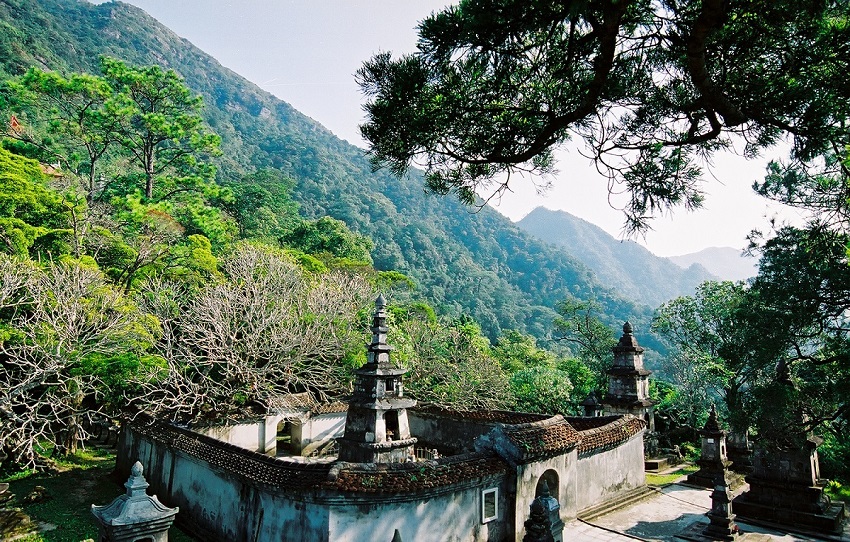
Hue Quang Kim Thap Stupa is nestled in the forest inside Yen Tu Mountain. Photo: Realtimes
Located on the border of three provinces of Quang Ninh, Bac Giang, and Hai Duong, Yen Tu Mountain is considered a “sacred land”, attracting hundreds of thousands of local and international tourists every year.
This is because Yen Tu is home to the Truc Lam (Bamboo Forest) Buddhist sect and also a tourist attraction near Hanoi.
According to Michael Keller, General Manager of Legacy Yen Tu MGallery by Sofitel, it is extremely easy for travelers from Hanoi to reach Yen Tu Mountain.
“Our guests are mainly from Korea, Japan, and European countries. They often choose to stay in Hanoi for a few days before embarking on a journey to explore this sacred mountain,” he told The Hanoi Times.
Moreover, Hanoi and Quang Ninh Province are perfectly connected by a highway, which helps to further promote the tourism potential of both destinations, he added.
Tourists often choose a three- or four-day tour with departure from Hanoi to Ha Long and Yen Tu. On the first morning of the trip, they can visit Con Son - Kiep Bac Relic Site en route, have lunch in Ha Long Bay and spend the third day exploring the Yen Tu Complex of Monuments and Landscapes, also known as Yen Tu Mountain.
A hidden gem in the pine forest
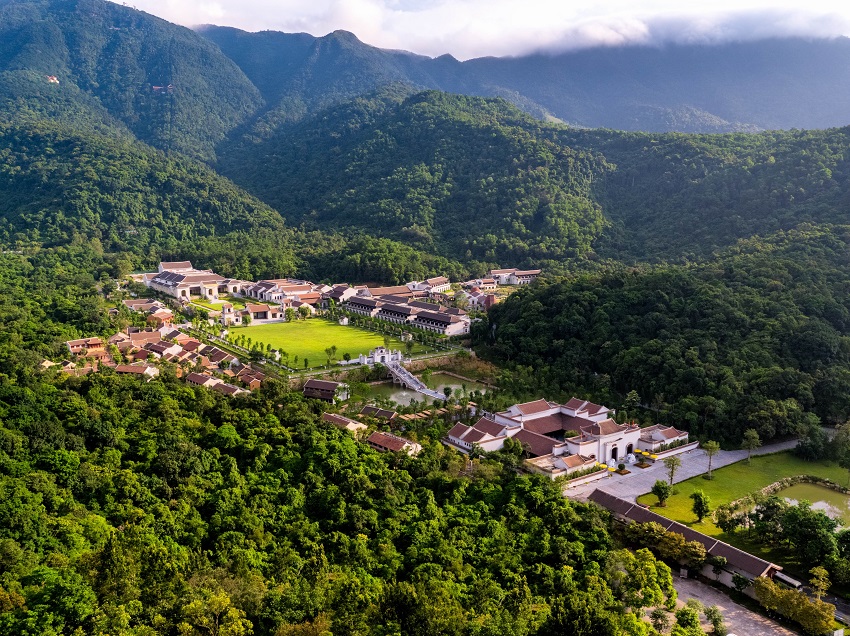
Legacy Yen Tu - MGallery bird's eye view. Photo courtesy of the resort
It's 3 pm on a beautiful summer day in August, and our gang of six girls and two boys arrived at Yen Tu. The General Manager of Legacy Yen Tu Resort greeted us with a big smile. The distance from Hanoi to Yen Tu is short enough to bring us there without stopping for rest on the way.
We chose to stay here the night before the trip to find the Vietnamese spiritual roots of the Truc Lam Zen Sect, the only school of Buddhism to originate in Vietnam.
For "busy bees" like us, this 17-acre ecological and Buddhist retreat is a great idea for a two-day, one-night escape, as it also offers wonderful accommodations nestled in a bamboo forest.
Designed by world-renowned architect Bill Bensley, Legacy Yen Tu - MGallery resembles an ancient palace from the 13th century Tran Dynasty. The retreat harmonizes with the Truc Lam Zen Commons, offering stays filled with history, enchantment, spiritual renewal, and rejuvenating wellness.
It is said that many architects were invited to design the site, but only Bill Bensley's plan respected the history and preserved the nature of the landscape.
It took Bill just one night at the tomb of King Tran Nhan Tong on Yen Tu Mountain to sketch out the design. Four months later, the perfect design was approved and the resort was completed within a year.
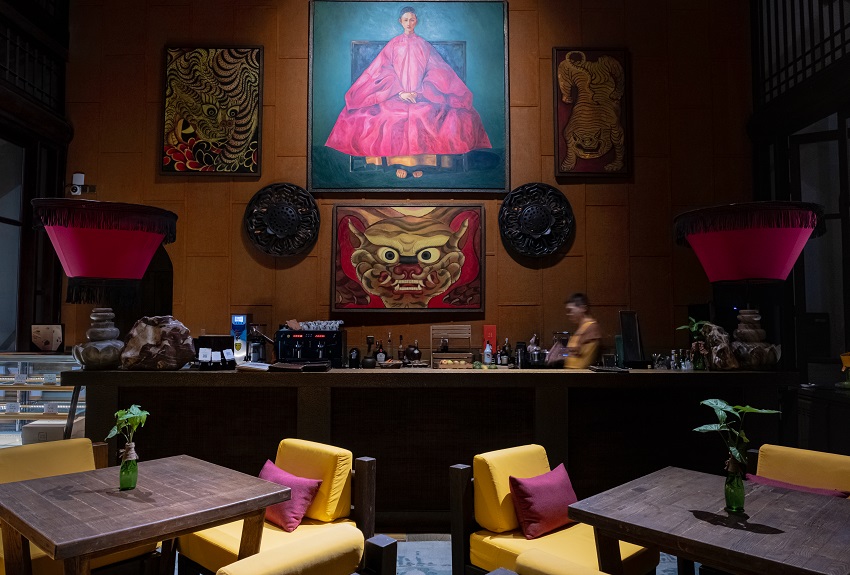
The space of Thien Quan Lounge at Legacy Yen Tu - MGallery. Photo: Quoc Anh
The sacred land of Buddha
Mt. Yen Tu, at approximately 1,068 meters above sea level, is the highest peak in north-eastern Vietnam. Located north of the provincial capital of Uong Bi and near the world-famous Halong Bay, it is also known as Elephant Mountain, because some say it resembles a reclining elephant looking out to the sea.
The mountain has played a role in history for centuries, as a place for monks to go in search of sanctuary and solitude. But the Yen Tu really came to prominence after the heroic Emperor Tran Nhan Tong abdicated in 1299 to practice Buddhism and achieve enlightenment here.
Together with two of his disciples, the monks Phap Loa Ton Gia (1284-1330) and Ly Dao Tai (1254-1334), the emperor is said to have founded the Truc Lam Zen Buddhist Sect, a humanistic Buddhism with typical Vietnamese characteristics. Yen Tu Mountain was then considered to be the Buddhist Capital of Vietnam.
Before Nhan Tong came to prominence for his religious activities, he had already established a reputation as a strong and just ruler. Aided by the legendary general Tran Hung Dao, the young king led the nation to victory in two wars against the invading Mongols, in 1285 and 1288.
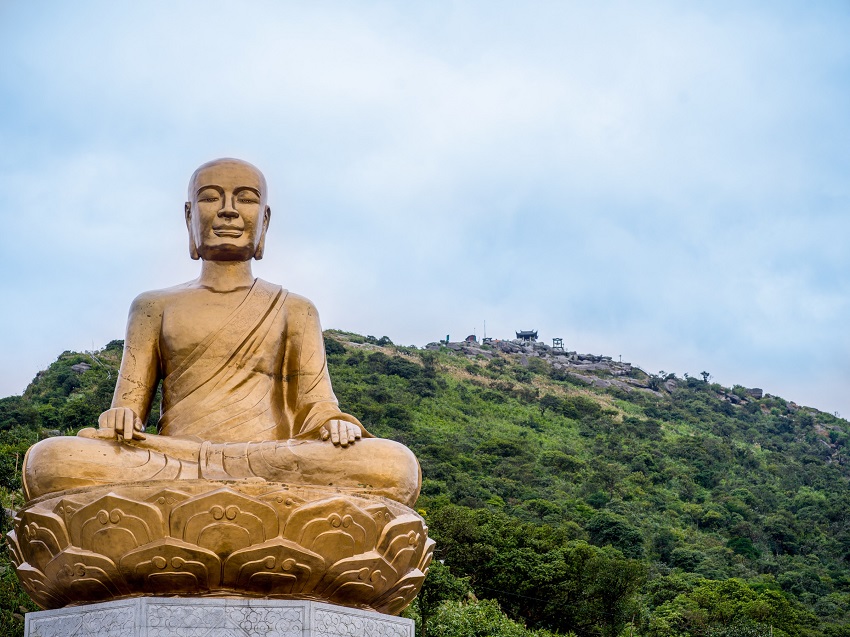
The giant statue of Buddha Emperor Tran Nhan Tong (1258-1308) in Yen Tu Mountain. Photo: Viet Trung
Conquering Yen Tu Mountain
In Yen Tu, those seeking a quicker route to salvation can take the cable car. It may seem like cheating, but the views are magnificent. Two modern cable car systems here are said to be able to transport large numbers of Buddhists and tourists to the site.
The many places to visit along the way are said to follow the path of Tran Nhan Tong on his first pilgrimage. The first stop is Suoi Tam or Bathing Brook, which is the place where he washed off the dust and dirt of his earthly life. Not far away is a pagoda called Cam Thuc or Fasting, where the king was said to have had his first vegetarian meal.
The next destination is Giai Oan Stream (Salvation of Wandering Souls).
A short walk takes us up to Hue Quang Kim Thap Stupa, the eternal resting place of King Tran Nhan Tong, which is surrounded by 97 smaller stupas of Yen Tu monks from the Tran dynasty.

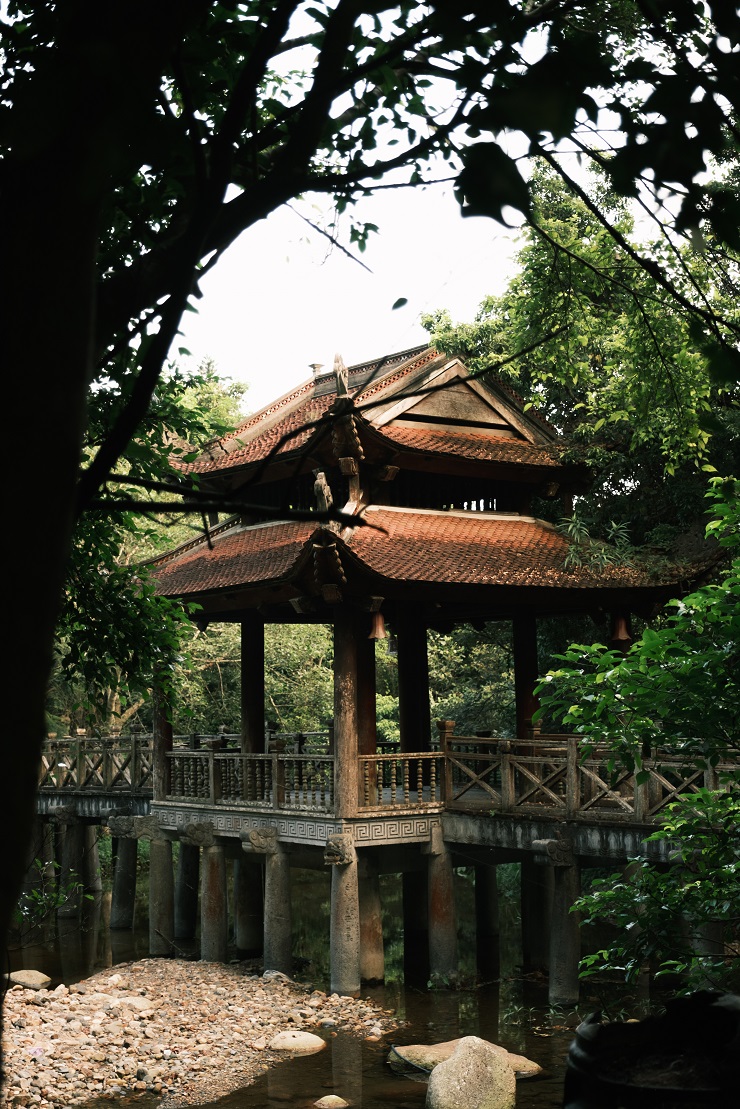
The bridge across Giai Oan Stream. Photo: Viet Trung
The largest and most beautiful edifice along the trail is the Hoa Yen Pagoda, located on a narrow strip of land 800 meters above sea level. This was the place where the retired king meditated, preached, and received his courtiers.
The final destination that requires a great deal of effort on the part of visitors, is the famous Dong or Bronze Pagoda, a small bronze temple located on the top of Yen Tu Mountain.
Legend has it that this peak is the last line separating heaven from earth, where the celestial world touches the clouds. It is said that whenever the pagoda’s bell rings, rain clouds gather.
Almost out of breath, Ly Nguyen, a companion of mine said after arriving at the pagoda that she was so tired but happy to admire the splendid panorama from the top of the mountain. “It is a wonderful climb!” she said, “climbers go higher, giving the impression of an ascent to heaven.”
Indeed, after nearly four hours of climbing, we feel it’s an accomplishment. And like every pilgrimage, the path tests our perseverance and our faith in Tran Nhan Tong, the great heroic Emperor of the country and the Buddha of Truc Lam Zen Sect.

Hoa Yen Pagoda is the place where Buddha Tran Nhan Tong meditated, preached, and received his courtiers. Photo: Viet Trung
Jenna Duong